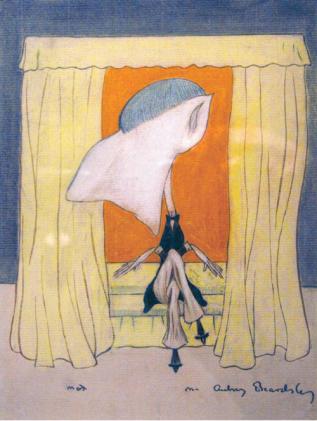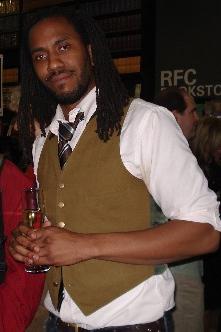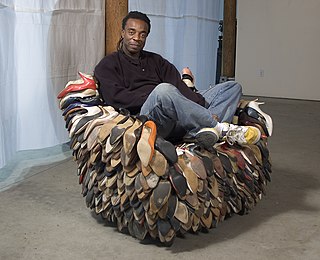
A caricature is a rendered image showing the features of its subject in a simplified or exaggerated way through sketching, pencil strokes, or other artistic drawings. Caricatures can be either insulting or complimentary, and can serve a political purpose, be drawn solely for entertainment, or for a combination of both. Caricatures of politicians are commonly used in editorial cartoons, while caricatures of movie stars are often found in entertainment magazines.

Solomon "Sol" LeWitt was an American artist linked to various movements, including conceptual art and minimalism.

William Kentridge is a South African artist best known for his prints, drawings, and animated films, especially noted for a sequence of hand-drawn animated films he produced during the 1990s. The latter are constructed by filming a drawing, making erasures and changes, and filming it again. He continues this process meticulously, giving each change to the drawing a quarter of a second to two seconds' screen time. A single drawing will be altered and filmed this way until the end of a scene. These palimpsest-like drawings are later displayed along with the films as finished pieces of art.

Jim Morin is the internationally syndicated editorial cartoonist at the Miami Herald since 1978 and a painter, usually working in the medium of oil, of more than 40 years. His cartoons have included extensive commentary on eight U.S. presidents: Richard Nixon, Gerald Ford, Jimmy Carter, Ronald Reagan, George H. W. Bush, Bill Clinton, George W. Bush, Barack Obama and Donald Trump.
Gene Davis was an American Color Field painter known especially for his paintings of vertical stripes of color.

Rita Ackermann is a Hungarian-American artist. She lives and works in New York City.

The Pérez Art Museum Miami (PAMM)—officially known as the Jorge M. Pérez Art Museum of Miami-Dade County—is a contemporary art museum that relocated in 2013 to the Museum Park in Downtown Miami, Florida. Founded in 1984 as the Center for the Fine Arts, it became known as the Miami Art Museum from 1996 until it was renamed in 2013 upon the opening of its new building designed by Herzog & de Meuron at 1103 Biscayne Boulevard. PAMM, along with the $275 million Phillip and Patricia Frost Museum of Science and a city park which are being built in the area with completion in 2017, is part of the 20-acre Museum Park.

Rashid Johnson is an American artist who produces conceptual post-black art. Johnson first received critical attention in 2001 at the age of 24, when his work was included in Freestyle (2001) curated by Thelma Golden at the Studio Museum in Harlem. He studied at Columbia College Chicago and the School of the Art Institute of Chicago and his work has been exhibited around the world.

Willie Cole is a contemporary American sculptor, printer, and conceptual and visual artist. His work uses contexts of postmodern eclecticism, and combines references and appropriation from African and African-American imagery. He also has used Dada’s readymades and Surrealism’s transformed objects, as well as icons of American pop culture or African and Asian masks.

Arturo Herrera is a Venezuelan-born (1959), Berlin-based visual artist known for wide-ranging work that is rooted in the practice of collage. His colorful, often rhythmic art intertwines bits of pop iconography, gestural marks and nonrepresentational shapes using pictorial strategies of fragmentation, repetition, effacement and dislocation. The resulting imagery often balances between abstraction and figuration, detached from inherent narratives yet vaguely familiar. Critics suggest that this ambiguity engages memory, fantasy and a viewer's unconscious private interpretive schemes, evoking a multiplicity of references and readings. In 2020, Art in America writer Ara H. Merjian described Herrera's practice—which includes works on paper, paintings, reliefs, sculpture, public art and books—as "chameleonic as [it] is consistent," one that "breathes life into modernist collage, exploring the tensions between exactitude and spontaneity, placement and displacement."
Edward (Ed) Clark was an abstract expressionist painter known for his broad, powerful brushstrokes, radiant colors and large-scale canvases. An African-American, he wasn’t widely recognized as a major modernist until relatively late in a seven-decade career, during which he pioneered the use of shaped canvases and of the everyday push broom to create striking works of art.

Xaviera Simmons is an American contemporary artist. She works in photography, performance, painting, video, sound art, sculpture, and installation. Between 2019 and 2020, Simmons was a visiting professor and lecturer at Harvard University. Simmons was a Harvard University Solomon Fellow from 2019-2020. Simmons has stated in her lectures and writings that she is a descendant of Black American enslaved persons, European colonizers and Indigenous persons through the institution of chattel slavery on both sides of her family's lineage.

Simone Leigh is an American artist from Chicago who works in New York City in the United States. She works in various media including sculpture, installations, video, performance, and social practice. Leigh has described her work as auto-ethnographic, and her interests include African art and vernacular objects, performance, and feminism. Her work is concerned with the marginalization of women of color and reframes their experience as central to society. Leigh has often said that her work is focused on “Black female subjectivity,” with an interest in complex interplays between various strands of history. She was named one of the 100 most influential people in the world by Time magazine in 2023.
Charles Gaines is an American artist whose work interrogates the discourse of aesthetics, politics, and philosophy. Taking the form of drawings, photographic series and video installations, the work consistently involves the use of systems, predominantly in the form of the grid, often in combination with photography. His work is rooted in Conceptual Art – in dialogue with artists such as Sol LeWitt, Lawrence Weiner and Mel Bochner – and Gaines is committed to its tenets of engaging cognition and language. As one of the only African-American conceptual artists working in the 1970s, a time when political expressionism was a prevailing concern among African-American artists, Gaines was an outlier in his pursuit of abstraction and non-didactic approach to race and politics. There is a strong musical thread running through much of Gaines' work, evident in his repeated use of musical scores as well in his engagement with the idea of indeterminacy, as similar to John Cage and Sol LeWitt.
Margo Leavin (1936–2021) was an American art dealer. She was born in New York, but spent her career in Los Angeles. In 1970, she opened the Margo Leavin Gallery in West Hollywood, CA, which she operated until it closed in 2013.

Kim Schoenstadt is a Los Angeles based artist. She currently lives in Venice, California.
Antonio José de Barros Carvalho e Mello Mourão, known professionally as Tunga, was a Brazilian sculptor and performance artist. Tunga was born in Palmares, Pernambuco, Brazil.
Christina Quarles is a queer, mixed contemporary American artist and writer, living and working in Los Angeles, whose gestural, abstract paintings confront themes of racial and sexual identities, gender, and queerness. She is considered at the forefront of a generation of millennial artists and her works shatter the societal manners of physical classification.
Ana Teresa Fernández is a Mexican performance artist and painter. She was born in Tampico, Tamaulipas, and currently lives and works in San Francisco. Fernández attended the San Francisco Art Institute, where she earned bachelor's and master's of fine arts degrees. Fernández's pieces focus on "psychological, physical and sociopolitical" themes while analyzing "gender, race, and class" through her artwork.
Manuel Mathieu is a contemporary visual artist best known as a painter of abstract works that often evoke figurative shapes in nondescript environments. Mathieu draws from Haitian visual cultures and from Western art movements such as expressionism and existentialism. His practice weaves together formal techniques, Haitian contemporary art movements to explore phenomenologies of human relations as they relate to power dynamics, loyalty, love, nature, subjective experience, history writing. His subjects matters start as personal concerns that he embeds into larger collective contexts.













